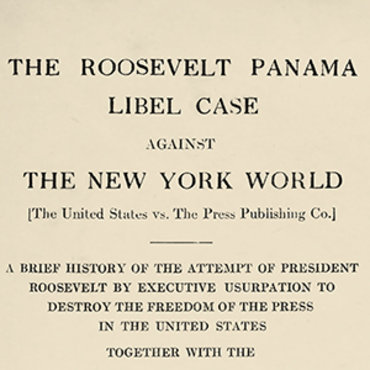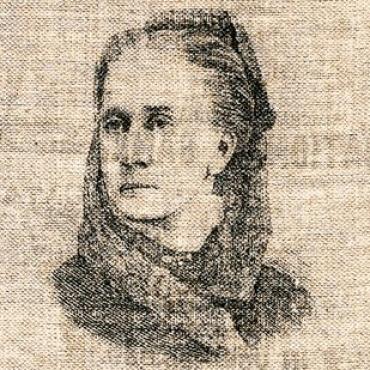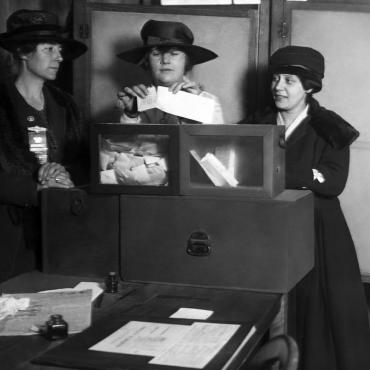
Give Women the Vote? Analyzing Suffrage Propaganda
Students use examples from the pro- and anti-suffrage movements to dissect the persuasive techniques used to shape public opinion then and now.
Get even more great free content!
This content contains copyrighted material that requires a free NewseumED account.
Registration is fast, easy, and comes with 100% free access to our vast collection of videos, artifacts, interactive content, and more.
NewseumED is provided as a free educational resource and contains copyrighted material. Registration is required for full access. Signing up is simple and free.
With a free NewseumED account, you can:
- Watch timely and informative videos
- Access expertly crafted lesson plans
- Download an array of classroom resources
- and much more!
- Journalism
- Politics
- Women's Rights
- 6-12
- Tell students they’re going to do an activity to understand how social movements attempt to change people’s minds about an important issue. Explain that the women’s suffrage movement was a decades-long effort to win women the right to vote, which finally culminated in the ratification of the 19th Amendment in 1920. During this long battle, both supporters of woman suffrage and those opposed created many messages to try and win supporters for their side. Some of those messages are presented on the Women’s Suffrage Media Map.
- Hand out the Give Women the Vote? worksheet. Go over the persuasive techniques on the first page to make sure students have a general understanding of what they will be looking for.
- Assign or let students choose an artifact from the media map to analyze. They may work in teams, pairs or individually.
- When students have completed their worksheet, look at the media map artifacts as a class and discuss the questions below.
- Give Women the Vote? worksheet (download), one per student
- Access to the Women’s Suffrage Media Map below

Women's Suffrage Media Map
Women's Suffrage Media Map
- Which techniques were most commonly used? Why? Are these same techniques used widely today?
- Which techniques do you think are the most effective? Why?
- Do you think these persuasive messages/artifacts affected the eventual outcome of the suffrage debate? Explain.
- How are today’s persuasive messages similar to those from the suffrage debate? How are they different? How do you explain the similarities and differences?
- What additional persuasive techniques do the modern-day media have available to them due to technological developments?
- Why is it important to understand the tools and influence of persuasive messages? What impact did they have on history? What impact do they have on our lives today?
Brainstorm current social and political issues that generate widespread debate (such as gun control, soda taxes, immigration, etc.). Divide your class into small groups and let them select one of the topics. Have each group gather 8-10 examples of persuasive messages surrounding their chosen issue. Remind students to find examples of messages representing different viewpoints. Have each team prepare a presentation about the arguments and persuasive techniques they found being used in the debate.
-
Common Core State Standards: CCSS.ELA-LITERACY.CCRA.R.1
Read closely to determine what the text says explicitly and to make logical inferences from it; cite specific textual evidence when writing or speaking to support conclusions drawn from the text. -
Common Core State Standards: CCSS.ELA-LITERACY.CCRA.R.4
Interpret words and phrases as they are used in a text, including determining technical, connotative, and figurative meanings, and analyze how specific word choices shape meaning or tone. -
Common Core State Standards: CCSS.ELA-LITERACY.CCRA.R.6
Assess how point of view or purpose shapes the content and style of a text. -
Common Core State Standards: CCSS.ELA-LITERACY.CCRA.SL.1
Prepare for and participate effectively in a range of conversations and collaborations with diverse partners, building on others' ideas and expressing their own clearly and persuasively. -
Common Core State Standards: CCSS.ELA-LITERACY.CCRA.SL.2
Integrate and evaluate information presented in diverse media and formats, including visually, quantitatively, and orally.
-
NCSS C3 Framework: D3.4.6-8 and D3.4.9-12
6 - 8. Develop claims and counterclaims while pointing out the strengths and limitations of both. 9 - 12. Refine claims and counterclaims attending to precision, significance, and knowledge conveyed through the claim while pointing out the strengths and limitations of both.
-
ISTE: 3d. Knowledge Constructor
Students build knowledge by actively exploring real-world issues and problems.
-
National Council of Teachers of English: NCTE.1
Students read a wide range of print and non-print texts to build an understanding of texts, of themselves, and of the cultures of the United States and the world; to acquire new information; to respond to the needs and demands of society and the workplace; and for personal fulfillment. Among these texts are fiction and nonfiction, classic and contemporary works.











































